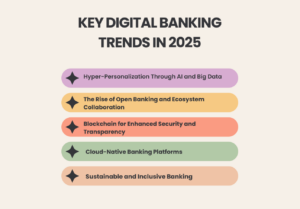Digital Banking Transformation in 2025: Pivots and Trends
The banking industry has been transforming with digital transformation, growing client expectations, and advanced technological breakthroughs. In 2025 digital banking has become more than a futuristic vision to a modern necessity. To be at the forefront of digital evolution, financial institutions have refurbished their operations and have improved the customer experience with advanced technology and digital transformation.
This blog examines the shifts and developments in digital banking that will transform the financial industry by 2025. We may learn how customer-centric innovations, changing tactics, and technological breakthroughs redefine banking.
The Driving Force Behind Digital Banking Transformation
Banking transformation has been powered by many factors:
- Customer Expectations: All customers now expect an easy, personalized and instant banking experience. For finance management from anywhere without any constraints of traditional banking, customers prefer digital as it can be done anytime.
- Technological Advancements: With artificial intelligence, blockchain technology, and cloud computing, banking has become more convenient for customers as it is now more organized, and easily manageable.
- Competition from FinTechs: With the growth of FinTech companies, traditional banking has been declining and these established institutions are more innovative and risk-resistant.
- Regulatory Changes: Government and regulatory bodies are now increasingly encouraging regulatory bodies to encourage digital transformation to improve financial inclusion and transparency.
Key Digital Banking Trends in 2025

- Hyper-Personalization Through AI and Big Data
Hyper-personalization has been made possible by the biggest trend of integrating AI with big data. It has used the customer’s data to deliver tailor-made financial products, predictive insights, and proactive support from the banks.
For example, AI-based chatbots can analyze a customer’s spending habits and give real-time budgeting advice. Similarly, banks are using machine learning algorithms to predict life events, such as buying a home or starting a family, and offering relevant financial solutions. - The Rise of Open Banking and Ecosystem Collaboration
With the opening of banking, the financial sector is now enabling third parties like mobile app development companies to create applications and services that cater to financial institutions. This will increase the collaboration between banks, FinTechs, and various other industries which interconnects the financial environment.
From 2025 banks will be empowering customers to access the spectrum of financial services within a single platform. For instance, with a banking mobile app, customers will be able to manage their accounts, invest in stock, and even book vacations, everything within a single platform. - Blockchain for Enhanced Security and Transparency
Another pivoting banking transformation is blockchain technology, it will decentralize and enhance security, transparency, and effectiveness in financial services.
In 2025 the banking industry will move to blockchain for different uses like cross-border transactions, fraud detection and prevention, smart contracts, etc. For example, with blockchain, the cost and time for international transactions can be reduced while ensuring tamper-proof records. - Cloud-Native Banking Platforms
Another trend that has been mending the future of banking is the jump to cloud-native platforms. With scalability, flexibility, and cost-effectiveness, cloud computing will allow banks to innovate and deliver to customers which can improve their experience.
Banks are more likely to shift their core system to the cloud in 2025, this will allow them to provide real-time data and manage the integration of their-party services. This can be a supportive step for adopting and integrating AI, IoT and other advanced technologies. - Sustainable and Inclusive Banking
Digital banking transformation has given more importance to sustainability and financial inclusion, customers are more likely to prioritise ethical and environment-friendly banking practices.
To be a part of this, banks are now introducing green financial services and options, carbon footprint tracking methods and more initiatives to support underserved communities. In 2025, sustainable banking will be a moral imperativeness and a strategic advancement for the financial sector.
Strategic Pivots for Banks in 2025
Banks need to change their strategies to capitalize on these trends which goes with the evolving financial landscape.
- Invest in AI and Automation: To improve customer experience, operations and cost-effectiveness, banks must give priority to AI-driven solutions.
- Embrace Open Banking: To be at the forefront of industrial competition, banks need to collaborate with Fintech and other industries.
- Adopt Blockchain Technology: With blockchain, financial transactions will be more transparent, secure and efficient.
- Migrate to the Cloud: For future innovations, cloud-native platforms have to be agile and saleable.
- Focus on Sustainability: For customer expectations and regulatory requirements, banks are required to include sustainability as one of their integral strategies.
Conclusion
The 2025 trends in banking have revolutionized it for customers, with advanced technology and customization. Banks can now upgrade the future of financial services and improve client satisfaction by using technologies like generative AI, blockchain, invisible banking, etc. With the transformation of banking the customer experience has also been improved and many advantages like sustainability have been put into action.
FAQ
- How is generative AI used in banking?
Generative AI in banking is used to give customers personalized financial advice, product recommendations and proactive services that offer solutions based on customer data and behavioural patterns. - How beneficial is invisible banking?
This allows customers to perform bank transactions with ease, unlike traditional backing. This will enhance the customer experience - What does blockchain do with modern banking?
Blockchain technology provides a decentralized ledger that enhances transaction transparency, security, and efficiency. In banking, it is used for secure transactions, reducing fraud, and managing cross-border payments. - Why is there a renewed focus on human elements in digital banking?
While digitalization has improved efficiency, it has often led to impersonal customer interactions. Reintegrating human elements ensures that customers receive empathetic and personalized service, rebuilding trust and loyalty. - What are the main challenges in banking digital transformation?
Key challenges include building customer trust in AI-driven services, ensuring data security and privacy, and navigating complex regulatory environments associated with new technologies and digital assets.
